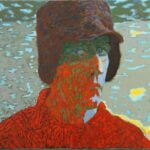
Gražys Bronius
Bronius Gražys was born on September 17, 1952 in Kaunas. In 1970-1976 he studied painting at the Vilnius State Institute of Art. Since 1985 – a member of the Lithuanian Artists’ Union. Since 1990 – a member of the group “24”. Since 1983 he has been teaching at the Vilnius Academy of Arts. In 1993 he was awarded the pedagogical title of associate professor. Lives and works in Vilnius.
Participates in exhibitions since 1976.
Awards:
1977 Klaipėda City Prize (exhibition “Days of the Sea”)
1990 “Literature and Art” Editorial Prize (VIII Baltic Painting Triennial)
1992 Kultur & Kontakt Scholarship of the Austrian Ministry of Education and Culture
1999 – 2000 Lithuanian Ministry of Culture Highest Degree Scholarship
2000 Prize for Painting at the 1st Biennial of Small Forms of Painting and Graphics “Lilla Europa 2000”, Hallsberg & Orebro, Sweden
Works have been acquired by:
Lithuanian Art Museum, Vilnius; Lithuanian Ministry of Culture, Vilnius; M.K.Čiurlionis Art Museum, Kaunas; Tretyakov Gallery in Moscow, Russia; Lithuanian Art Foundation, Vilnius; private collectors in Lithuania and abroad.
Personal exhibitions:
1977 Painting. Varėna Culture House
1979 Painting. Varėna Culture House
1993 Painting. “Vartų” Gallery, Vilnius
1994 Painting and drawings, “Lietuvos Aidas” Gallery, Vilnius
1994 Painting. “Baroti” Gallery, Klaipėda
1995 Pastels, acrylic painting. “Arka” Gallery, Vilnius
1998 Painting. “Akademija” Gallery, Vilnius
2001 Painting. “Lietuvos Aidas” Gallery, Vilnius
2002 Painting and drawings. “Lietuvos Aidas” Gallery, Vilnius
2006 Painting. “Dreaming Tree”. “Lietuvos Aidas” Gallery, Vilnius
2008 Painting. “Continuity”. “Lietuvos Aidas” Gallery, Vilnius
Important group exhibitions:
1976-1989 Republican Fine Arts Exhibitions in Lithuania
1977, 1978 Exhibition “Sea Days”. Klaipėda Palace of Culture
1979 1st Baltic Young Artists Painting Triennial. Art Exhibition Palace, Vilnius
1983 Painting exhibition of five artists. Šiauliai Art Exhibition Palace
1986 Graphics and drawings. Moscow Palace of Artists, Russia
1987 Painting exhibition of young artists. Central Exhibition Hall “Maniež” in Moscow, Russia
1988 Painting exhibition of young Lithuanian artists in Helsinki, Finland
1988 14 artists from Lithuania. Lithuanian House in Philadelphia, USA
1988 Exhibition of works by young Lithuanian artists. Gdynia City Reading Room, Poland
1989 Exhibition of Paintings and Graphics by Lithuanian Artists in New York, USA
1989 Lithuanian Art Exhibition at the “Konstepidemin” Gallery in Gothenburg, Sweden
1990 8th Baltic Painting Triennial. Art Exhibition Hall, Vilnius
1990, 1991, 1996 Group “24” Exhibition. Contemporary Art Center, Vilnius
1990 Lithuanian Art Exhibition in Glugsburg, Germany
1992 Lithuanian Painting. “Inside” Gallery, Belgium
1992 Lithuanian Painting. “Ridderkerk” Gallery, Holland
1992 Group “24” Exhibition in Kaunas, Panevėžys, Šiauliai, Kėdainiai
1992 Painting and Drawings. “Edition Thurnhof” Gallery, Horn, Austria
1993, 1997 Group “24” exhibition at the “Lietuvos Aidas” Gallery, Vilnius
1994 Group “24” exhibition at the “Parvi” Gallery in Paris; Municipal Library in Tours, France
1995 International Plein Air – “M.K.Čiurlionis – 12 0”, “Small Gallery”, Druskininkai
1996 Exhibition of painters from the “Lietuvos Aidas” Gallery at the Lithuanian Embassy in Moscow, Russia
1997 Group “24” exhibition at the Riga Museum of Modern Art Arsenals, Latvia
1997 “Baltic Plein Air’97”, Palanga
1998 Lithuanian Painting. Contemporary Art Center in Ankara, Turkey
1999 International Plein Air Painting in Daugavpils
2000 “Baltic Art”. New York, Washington, Los Angeles, Chicago (USA)
2000 Lithuanian Painting. Cultural Center in Warsaw, Poland
2000 “Lilla Europa 2000”. 1st Biennial of Painting and Graphics of Small Forms. Hallsberg & Orebro, Sweden
2000 Group “24” exhibition at “Grosvenor House” in London, England
2001 Painting exhibition “Arte & Maggio” in St. Scholastica Monastery in Bari and Rome, Italy
2001 VIII International Baltic Music and Art Festival “Probaltica 2001” in Toruń, Poland
________________________________________________________________
“Vision Painting” – this is how we could sum up the artist’s work, having reviewed it from the very first works created over twenty years ago to the paintings of recent years. There have certainly been changes – primarily in the field of plastic expression – but the worldview revealed in the paintings has remained stable. It is characteristic that B. Gražys’ vision painting appeared at that time along with the increasingly strong tendency of Lithuanian painting to delve into the subconscious, to create images full of the absurd and grotesque.
The artist appeared in his first works as a creator of conventions, not afraid of sharp plots and fantastic compositions. He was concerned, and still constantly strives, to create strange, a mysterious, sometimes artificial world with its surroundings. The latter is full of illogicality and paradox, allegories and “visions” that are only possible in dreams. The painted images translate our everyday life into another, unconditional reality, as if saying that everything can lose its physical and spiritual identity, become a new body or simply disappear.
in an ethereal form. These are attempts to change the relationships between things and phenomena, to look at reality not through the usual “recognition” glasses. Perhaps – and to provoke the perceiver with such enigma of images.
On the other hand, why not call these vision paintings another branch of romantic creativity, already continuing in the 21st century, which is nothing more than the creator’s constant desire to extract the secrets of the world and man, to combine ignorance with knowledge, one’s intuitions with faith?
Connections and separations.
“Connections and separations” appeared in painting already at the beginning of his work: the artist liked to depict motifs that came from various spheres – nature, everyday environment or imagination, he painted human figures or clumped masses of objects against the background of strange landscapes, the space of the paintings turned out to be more fantastic than real, although at the same time the forms of realistic objects were visible in it. Such artistic intentions of the author seemed quite radical against the background of Lithuanian painting of that time, where expressive pastotic painting, the ability to create a pleasing coloristic image structure or balancing on the verge of abstraction were still highly valued. A strange, metaphorical, illogical world of forms and combinations with a dose of grotesque or irony was just drawing its own trajectories. Over time, nature in direct forms (landscape, its motifs, forms, etc.) began to recede from B. Gražys’ paintings: the images increasingly veered towards unreality, the details that defined the identity of nature disappeared in them (although fragments of a lake or river were found), and the surrounding nature for the depicted scenes was simply no longer necessary. The perspective was closed by colorful planes, and only their small cracks or opening narrow cavities allowed us to believe that the image created in the foreground still has a mysterious “back”, a space that raises allusions to mystery, the unknown or emptiness. Here, “connections and separations” also gained their plastic expression.
Seams.
They are like an author’s mark-autograph of B. Gražys’ paintings, the meaning of which is primarily associated with the connections of the created visions, forms, shapes of objects and figures, and their combinations. Formally speaking, the “seams” actually serve no other purpose: they connect, lace up colorful planes, objects, figures, creating the plastic intrigue of the entire image (often their derivation is ingenious and visually effective). Looking deeper, it seems that we would encounter a more complicated meaning of the “threads”, with the nature of the author’s worldview and feelings. Then the content of the “connections and separations” also looks different. B. Gražys’ visions begin to speak as “otherworldly”, visual constructions born beyond visible reality – in thoughts, intuitions, visions, plots woven by the imagination or simply crazy. They are timeless and spaceless (only to the extent that their plastic structure determines the spatial parameters).
What is connected is distant or incompatible in terms of space, time, physical meaning, practical purpose of things, real life. But not without the tension and power of contrasts of the depicted motifs, because pictorial combinations of connections do not maintain a solid fabric: they tear, split, divide into several planes, and disintegrate. In the latter case, the paintings emphasize the “cracks”, black holes or cracks in the background planes, which could metaphorically describe the disconnection of the physical and spiritual principles. The identity of objects, humans, and animals is lost or difficult to grasp (let’s look at a painted human or animal figure – these are more like innards, shells, skeletons). The secrets of humans and nature are still difficult to grasp. Romanticism once again confuses. “Threads” remain as a sign, showing an attempt to connect and harmonize the different natures of objects and humans, the real and imaginary world.
Motifs.
But the “seam”, repeating stitches, is also a motif. Its visual form is pronounced like a spell, without which no plastic intrigue arises. Often in the image it becomes a line that merges the shapes of objects, resembles a sign or turns into a dotted line running through the image – like rosary beads. Such a pictorial evolution of the seam – line naturally leads towards another possible plastic sign – the loop. The paintings where this is done are impeccable, economical, penetrating the brain. B. Gražys also has several other, especially favorite motifs – objects, constantly appearing in compositions. These are – a fish, a cat, a cup-shaped vessel. Also the human figure, which, as mentioned, often resembles the shape of a gut, a shell, a hollow form. True, the frequency of these motifs in the author’s works is not as consistent as “seams”, but they significantly complement the interpretations of “couplings and separations”. On the other hand, the semantic connections of fish and man, fish and cat(!), vessel and human figure (head, face) are not so interesting in their content as in their plastic properties.
In general, the combinations of motifs are not alien to the surrealist beginning, the intersection of meanings and the accents of fantasy, strangeness, and dreams. This unreal world is not dense and saturated with oddities: the author’s compositions are not limited to
with many figures, motifs. This is their advantage. Secondly, no matter how strange, phantasmagorical the combination of motifs may be, it does not show (which we find enough in surrealist painting) signs of fear, menacing instinct, action or mental confusion. The motifs depicted by B. Grazius, having broken away from conventional thinking, have shifted more towards calm contemplation, peaceful contemplation, only occasionally does irritability or nervousness appear.
Color.
B. Grazius’s painting, which at the beginning of his work was dark for some time, inclined to black, gloomy colors, and their subdued combinations, has brightened considerably in recent years, even becoming more decorative, with more active, sharper colors. Now there is more sun, light and brightness. In some places, the colors left by the “stepping” stroke covering the plane resemble a mosaic, vibrating texture, in which a black “slit” – like a knife at the right time and place. There are examples when the color range of the background almost approaches abstraction, in which the definitions of objects sink, disappear. However, the vocabulary of abstraction is not an acceptable form of expression for the author. But the range of subtle, muted colors, evenly spread across the plane of the image, does not die either. It is an oasis of freshness for the eyes, a shade from the light of bright colors. And when in such a subtly nuanced color texture only the remnant of a “seam” appears – a graceful line or some kind of loop knot – you begin to think about order and peace. It seems that this is possible in visionary painting.
Art critic Viktoras Liutkus


